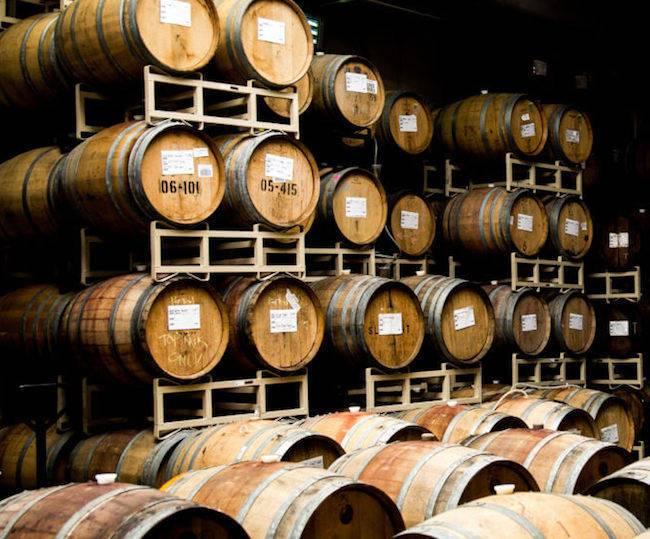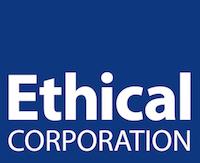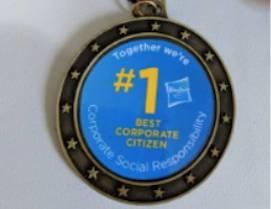100 Best Corporate Citizens Named by CR Magazine


CR Magazine has announced the 19th annual 100 Best Corporate Citizens list, recognizing the standout ESG performance of public companies across the US. The list was revealed in a Facebook Live broadcast.
The Top 10:
- Microsoft Corporation
- Accenture plc
- Owens Corning
- Intel Corp.
- Hasbro, Inc.
- Altria Group Inc.
- Cisco Systems, Inc.
- Ecolab, Inc.
- Johnson & Johnson
- NVIDIA Corp
See the full list here.
Several major themes emerged from this year’s list:
- Competition for millennials and Gen Z workforce. Millennials have a reputation as the "job-hopping" generation, and brands taking stands are cooler than companies solely in business to turn a profit. In 2016, a Gallup poll revealed that 21% of millennials said they changed jobs within the past year (more than three times the number of non-millennials who reported the same), and 60% are open to new opportunities. Research last year from Cone Communications demonstrated how Gen Z cares about purpose-driven companies.
- Investor interest in ESG factors. When BlackRock CEO Larry Fink issued an ultimatum in January 2018 to public company CEOs to be better corporate citizens, it confirmed that ESG investing is here to stay. Since then, hedge funds managers and activist investors are speaking outin support of investing in companies committed to sustainability.
- Jumps in ranking attributed to deeper integration between sustainability program and core business. Among those making big steps up in scores: Owens Corning, Becton, Dickinson And Co. Medtronic, IBM, and CVS.
- Biotech firms are well represented: Biogen, Becton, Dickinson And Co., Medtronic, and Edwards Life Sciences.
- Apparel companies are investing in sustainability: VF Corp, PVH, GAP, and Nike.
- Food companies scored well: General Mills, Hormel, and Pepsico.
- Many industries performed well because of compliance: especially the finance sector (banks).
To arrive at its ranking, the 2018 100 Best Corporate Citizens list analyzed 260 ESG data points of disclosure and performance measures from every Russell 1000 company in seven categories: environment, climate change, employee relations, human rights, governance, finance, and philanthropy and community support.
Companies were evaluated using publicly available records from their websites, annual reports, shareholder calls, media interviews, NGOs and government documents, not from private self-reports to analysts. Research was conducted by third-party accreditor ISS Corporate Solutions and there was no fee for companies to be assessed.
“CR Magazine is proud to present the only ESG ranking list that doesn’t rely on self-reporting,” said CR Magazine Publisher Dave Armon. “Each year, the 100 Best Corporate Citizens ranking measures the success of the Brands Taking Stands movement by celebrating the most successful, most transparent companies that report on their responsible practices.”
“The 100 Best ranking demonstrates that a company is dedicating resources towards its corporate responsibility and sustainability efforts,” explains Jen Boynton, Editor of CR Magazine. “Public disclosure allows its stakeholders to gain greater insights into a company’s business practices.”
On World Press Freedom Day: In Defense of the Media


By Marc Berliner
“Freedom of the press is not just important to democracy, it is democracy." - Walter Cronkite
May 3 was World Press Freedom Day, first proclaimed by the United Nations (UN) General Assembly in December 1993 to raise awareness of the importance of a free press and to remind governments of their duty to uphold the right to freedom of expression guaranteed by the 1948 Universal Declaration of Human Rights.
Per the UN, World Press Freedom Day is an opportunity to:
- “Celebrate the fundamental principles of press freedom;
- assess the state of press freedom throughout the world;
- defend the media from attacks on their independence;
- and pay tribute to journalists who have lost their lives in the line of duty.”
The theme for the 2018 celebration is “Keeping Power in Check: Media, Justice and The Rule of Law.” The theme is apt. I can’t think of a time in my lifetime when freedom of the press – protected by First Amendment to the United States Constitution – has come under such attack. When the leader of the free world rails against the media on a daily basis, going so far as to suggest jailing journalists, it’s clear that defending the press has never been more important.
Before I go any further, I have a confession to make. As a communications professional for 20+ years, at times I’ve been guilty of viewing journalists as merely a conduit for telling stories about my clients. While covering American business is one responsibility of the media, there is a much more critical role that the media plays in our society. Media helps create and shape public opinion and serves as a watchdog to protect the public interest against unethical, illegal and otherwise unseemly acts.
The debate over press freedom has become a daily topic of conversation – in the media, on the train, at the watercooler, at the dinner table… everywhere, really. Some media are accused of being too conservative, others are knocked for being too liberal. All types of media put up with allegations of “Fake News!”
But every day there are great examples of how the media serves the public interest. Consider the following:
- From Minimizing to #MeToo: Rampant sexual abuse would not have been exposed without the dogged reporting of journalists, like Ronan Farrow who ignored the threats of extremely powerful men
- Uncovering the Untold Story: While lesser known than the sexual abuse scandals plaguing multiple industries, this Bloomberg story on foreign hackers breaching U.S. nuclear sites is downright terrifying
- A New Perspective on a Widely-Covered Story: While numerous media outlets covered the white nationalist rally in Charlottesville, it was this chilling segment from Vice News that took viewers into the minds of leaders
- Relentlessly Giving a Voice to the Voiceless: The Washington Post won the 2018 Pulitzer Prize in Investigative Reporting for “purposeful and relentless reporting” that changed the course of a Senate race in Alabama by revealing a candidate’s alleged past sexual harassment of teenage girls and subsequent efforts to undermine the journalism that exposed it.
Regardless of your political affiliation or the issues you care about, it’s hard to argue against the importance of a free press. Pivotal moments in the history of our country would not have happened without the media.
So how can we support a free press? I’m not going to tell other people what to do, but I’ll share my approach. I’ve tried to carve out more time to read a variety of outlets that represent different viewpoints. It’s easy to get comfortable and consume media that fits our beliefs. But reading different perspectives on current events and key issues has made me more informed and empathetic to people on the other side.
In the words of UN Secretary-General António Guterres, “Promoting a free press is standing up for our right to truth.” As marketers and communications practitioners, we all have a role to play in supporting and promoting media by defending their right to tell the stories that must be told.
Marc Berliner is Senior Vice President, Cone Communications
Photo: UNESCO
New Hydrogen "Water Battery" Could Make Wind and Solar Greener


A new device that converts water to hydrogen gas could help solve an emerging carbon emissions dilemma for businesses and other electricity consumers. Companies want to be applauded for switching to wind or solar energy, but here in the US that choice is not necessarily as green as it could be. As long as coal and natural gas account for the lion's share of power generation in the US, companies that order up grid-supplied clean power may be unwittingly supporting a cushion of fossil fuels in the grid, too.
Part of the problem is that utilities are responding to the addition of wind and solar by adding new natural gas power plants, to smooth out supply and demand bumps. Grid stakeholders can also use energy storage to keep leveraging natural gas and coal into the grid. That's because they can store energy at night when rates are low, and then sell (or use) the low cost electricity during the day when peak demand grid prices kick in.
A Liquid Solution To The Carbon Emissions Problem
The good news is that the carbon emissions problem doesn't necessarily have to be in force forever. As more renewable energy enters the grid, the profile of natural gas and coal will keep shrinking.
So far natural gas has been the main driver pushing out coal. More recently, wind and solar are also beginning to gain an edge over both natural gas and coal (nuclear energy is a whole 'nother can of worms).
That's great, but it still dumps the issue of reliability onto the laps of utilities and grid operators.
Part of the solution is to manage demand. That can be complicated because it depends on behavior change, but solutions are already beginning to emerge. Some examples include "virtual power plant" technology that motivates consumers to change their habits. Incentivizing energy efficiency is another factor that could be ramped up.
Electric vehicles can also assume a larger role in their capacity as mobile energy storage units. Owners could be incentivized to charge up when demand is low, and even contribute their stored energy to help avoid reliability issues during peak demand periods.
That thing about EVs leads right back around to the energy storage problem. As the economy decarbonizes, the demand for energy storage will rise. Distributed solutions like EV batteries can pull some of the load, but energy insiders seem to agree that utility scale or bulk storage will also be needed far into the foreseeable future.
At this time, the consensus is that pumped hydropower is the only available strategy that makes economic sense for storing wind or solar energy in bulk.
Hydrogen gas is another water-based energy storage solution that Triple Pundit has been exploring at length, and that's where the new Stanford research comes in.
From water to hydrogen to energy storage
For those of you new to the topic, hydrogen is commonly used in food processing and other industries. It is also used for rockets and other space operations (NASA is a big fan) and it is increasingly used to power fuel cells, which generate electricity through a chemical reaction.
That fuel cell connection -- for forklifts, passenger cars and even semi trucks as well as stationary power sources -- means that in effect, hydrogen is an energy storage resource.
Hydrogen is cheap and abundant, but it doesn't come naturally. The main source of hydrogen today is natural gas. That's a problem of immense proportions in terms of local environmental impacts as well as greenhouse gas emissions.
Fortunately, natural gas does not have a lock on hydrogen production. Energy stakeholders are beginning to explore the use of biogas, and teams of researchers and industrial partners around the globe have been racing to develop technology that uses an electrical current to "split" hydrogen from water.
Ideally, that electricity would be generated by wind, solar or other renewables. The result is renewable hydrogen.
Finally, low-cost hydrogen energy storage
Water-splitting is a proven technology. The challenge is to make it more efficient and scale it up for bulk energy storage, while making it less expensive.The Stanford team tackled the challenge head on. As reported in the latest issue of the journal Nature Energy, they developed a new water based energy storage device that can be recharged numerous times to generate hydrogen gas.
So far they have demonstrated a prototype-scale model that can bubble off hydrogen gas when exposed to an electrical current. Once that reaction is depleted, the water battery can be recharged to start the process all over again.
The research team deployed a type of salt called manganese sulfate to do the job. It fulfills the requirements of inexpensiveness and abundance, and it is already a familiar substance in commercial use today.
The salt dissolves in water when the battery is charging up, which leaves particles of manganese dioxide on the electrodes (the electrodes are the parts of the battery that accept and discharge an electrical current).
When that reaction is depleted, the particles re-combine with water to reform back into manganese sulfate and the process can start all over again. In the new study, the team reported that the prototype successfully recharged 10,000 times.
One hitch is that the prototype includes a platinum catalyst to kickstart the chemical reaction. The high cost of platinum prevents its use for bulk scale energy storage.
On the plus side, now that the Stanford team has demonstrated a low cost, rechargeable hydrogen production system, they can focus on incorporating a less pricey catalyst.
They already have several candidates in mind that would come in under the $100 per kilowatt-hour mark. That's the goal set by the Department for commercially feasible bulk energy storage aimed at maximizing wind and solar resources.
The next step is to test the system in real-world grid storage scenarios, so stay tuned for more on that.
For more details, check out the study, "A manganese–hydrogen battery with potential for grid-scale energy storage" in Nature Energy.
And for the record, the study was funded by the US Department of Energy so let's have a group hug for taxpayers and a shoutout to the Stanford research team of senior author Yi Cui and co-authors Guodong Li, Hongxia Wang, Jiayu Wan, Lei Liao, Guangxu Chen, Jiangyan Wang, Hao Zhang, Zheng Liang, Yuzhang Li and Allen Pei.
Image (cropped): US Department of Energy.
Israel: Workforce Diversity is the Key to Building an Innovative Society


This article is sponsored by Maala and went through our normal editorial review process.
Israel is home to more than 15 different cultures, each with their own distinctive traditions and ancestral backgrounds. Although Israel is often characterized as the world’s only Jewish state, diversity is, and always has been at the heart of its identity as a nation.
Nowhere is that pluralism more evident than in the workforce that secures Israel’s technological edge. Arab Israelis fill an increasing role in today’s workforce as do new immigrants and communities that have been an integral part of Israeli society for decades, but whose members have traditionally not participated in white- or blue-collar jobs – until now.
But the path to increasing Israel’s workforce diversity hasn’t been easy, said Dr. Sigal Shelach, an authority on migration and employment in the Israeli workforce. Shelach currently serves as the senior deputy director of Israel’s Joint Distribution Committee (JDC-Israel) and CEO of its unique employment initiative, Tevet. In August she will assume the role of director general for JDC-Israel; an appointment that in itself reflects JDC's commitment to diversity. Shelach will be the first woman in history to head up the organization.
Shelach said that while Israel’s national unemployment rate is fairly low (3.7 percent, 2018), the country still faces unique gaps in its employment sector often not seen in other western nations.
“[There] is a big divide in the Israeli labor market,” said Shelach. While the broader employment sector will face challenges brought on by increased automation, the use of artificial intelligence and the increasing demand for upskilling in the coming decades, other communities that are only now entering the workforce face even more compelling demands for training, support and integration.
“[There are] at least two different societies that behave differently in the labor market than the rest of the jobs. One is the ultra-orthodox in Israel, in which the labor force participation for most of the men is very low,” Shelach explained. Haredi men are often encouraged by their families to focus on their religious faith rather than prepare for a secular career and therefore often lack the education and experience that they would need in a manufacturing or tech job. Haredi women, who are often the main bread-winners, face their own challenges, with few well-paying job opportunities.
Another group that faces challenges in the labor market is Israel’s Arab community, which until recently, has often shied away from employment in tech and manufacturing markets.
Israel’s Ethiopian Jewish community is seen by some as proof that Israel’s approach to diversity is actually working. Employment levels continue to rise for immigrants hailing from eastern Africa’s remote Jewish enclaves. But with the numbers of immigrants from Addis Ababa and Gondar, Ethiopia still expected to rise, the effort to integrate largely untrained new arrivals into the workforce continues.
Each community of workers faces its own exceptional challenges, said Shelach. And it’s been Tevet’s partnership with employers and the realization that a diverse workforce brings diverse thought and can actually promote innovation, that is helping to overcome those challenges.
These efforts are working. According to the Maala Index, between the years 2006 – 2017, rates of diversity and inclusion within the business sector in Israel have risen steadily. The number of women in managerial positions has risen from 20 percent to 30 percent, while the number of women in directorial positions has risen from 17 percent to 23 percent. Among the rated companies, the percentage of Israeli Arabs in the workforce has doubled from 2.4 percent to 5 percent, and the percentage of people with disabilities in the workforce has risen from 0.5 percent to 2 percent. However, despite these positive trends, there is still a way to go.
Osem-Nestle: Building new pathways to employment
Osem-Nestle is one of Israel’s largest food manufacturers, with more than a half-dozen factories spread across the country. In 2015, the company was selected to join a public-private partnership directed at increasing Arab participation in the national workforce.
According to Ofira Goldwasser, who serves as Osem-Nestle Group’s corporate responsibility manager as well as an assistant to the company’s chairman and CEO, the goal of the Collective Impact Program was to first answer a question: Why was Israeli-Arab participation in Israeli business sector so low?
“The candidate research results [revealed] that 50 percent [of applicants] had never applied for a job in the Israeli business sector from the Arab community,” said Goldwasser.
Yet there was also high employment potential. Roughly 70,000 young individuals in the Arab community would eventually need work. And Osem-Nestle needed workers it could train and then upskill to meet the increasing demand. It was easy to see a business case for getting involved in the Collective Impact initiative, Goldwasser said.
“The traditional industry in Israel is facing some challenges,” particularly when it comes to filling blue- and white-collar positions, she said. “So the business case was that we need employees and we need talent in order to grow and develop.”
In 2015, the Benjamin Netanyahu government increased government funding to address those gaps. In addition to providing more funding for housing and education in Arab communities, the new budget provided financial incentive for employers to increase their outreach, training and employment of Arab workers. Programs like the Excelling Arab Localities built new pathways for increasing services in Israel’s broadly scattered Arab neighborhoods.
But expanding its employment rolls also meant making some adjustment to the way hiring and training was carried out. “For example the Arab community needed to build some trust and to have some belief that if they were to apply to the business sector for example, they have a chance to get in,” Goldwasser explained.
To facilitate this, the company made adjustments to the application process and took into account that the candidates were coming from different cultural backgrounds with different language capabilities than say, applicants who spoke Hebrew as a first language.
Goldwasser said being sensitive to these barriers was important. But it didn’t mean the company was establishing different performance criteria.
“Because we are not making compromises. This is really important to understand. Being more open to our employees doesn’t mean that we are making compromises with the people we choose.”
Still, Osem-Nestle’s participation in the Collective Impact initiative has allowed it to expand diversity in its managerial ranks as well.
“[We] are successfully reaching talented Arab managers [from the community], and this has really created a more interesting organization.” She said by increasing the diversity at all levels of the company, Osem-Nestle has been able to encourage more innovation.
“[You] mix different cultures, you make different opinions, you have different ideas and it [becomes] a very good platform for innovation and for the growth of the organization,” said Goldwasser.
Unilever - Connected 4 Growth in Israel
In 2016, Unilever launched its Connected 4 Growth campaign. Designed to reach all 400 of its brands across the world, the program was meant to “create an organization that is faster, more agile and more competitive.”
For Unilever Israel, said Liat Lavee, Unilever Israel’s Communication, External Affairs and Sustainable Business Development Manager, that goal translated to making its employees digital-savvy.
In a country that has widely been touted as the world’s “Start-up Nation,” equipping employees with the tools to allow them to use social media and automated services both at home and at work was a practical choice, said Lavee.
“Basically the world around us is really changing at incredible speeds. Digitalization [is] impacting everything: How we work, how we live, how we play, and there really is a [need] for digitalization wherever we look.
“But what we also realized at Unilever Israel, is that the base of this change creates growing gaps between those who move with them and those that don’t keep up with the pace. It increases the social inequality and may also limit employment and promotion of those people who stay behind.”
To address this inequity, it launched company-wide trainings. It invited banking representatives to give workshops on how to bank online; it offered lessons on social media.
And it educated its managers on the importance of being sensitive to those workers who were insecure or complained they were “too old to learn these things.”
Lavee said the process is ongoing, but so far the results have been very favorable.
“There is an increased willingness to experiment and that is exactly what we wanted,” said Lavee. Surveys show that employees are more engaged and willing to take risks.
“At the end of the day, this is what we have learned: Digital is not a goal. It is a tool. And we really need to see the people themselves in the organization and understand what’s driving them, what drives them in their work, what drives them in life, and help them navigate the paths in which gives them satisfaction and development and gives them added value. And then that actually creates the win-win for the business as well.
“I think that is one good lesson that we have learned here in Israel.”
Unilever Israel’s digital training dovetails with another diversity project it had undertaken, which was to encourage a local Haredi community to help fill positions in a nearby factory.
To encourage candidates, the recruitment team reached out to community leaders. They met with rabbis, visited synagogues and made direct appeals to the community. And they listened to what cultural and social factors would best ensure retention of employees.
“What the team needed to do was think differently and act differently to connect with the ultra-Orthodox community that lives there. They approached them in a completely different way than you would in recruiting people normally,” by collaborating with the community in a way that encouraged participation.
Harnessing diversity is a collective effort
From Shelach’s perspective, it’s partnership that makes Israel’s focus on a diverse, multicultural workforce a success.
“We have to look at it from the standpoint that it is not only the responsibility of the employer … the individuals themselves, [or] the government,” said Shelach. The three, along with local unions play a role in ensuring a growing and diverse workplace.
For many businesses in Israel, diversity is a key component to success. Almost 10 years ago we initiated the Forum for Diversity Hiring in Israel,” said Shelach. “Today there are over 100 members who are the biggest businesses in Israel that are part of this forum.” ‘
Organizations like Maala, which hosts the Maala Con[Fair]ence each year are also behind these efforts. As companies like Unilever, Osem-Nestle, El Al Airlines and others have discovered, a diverse workforce is key to ensuring an innovative and market-ready business.
Images: Courtesy of JDC-Tevet/ Jonathan A. Stone
Do Green Company Acquisitions Make Multinational Corporations More Sustainable?


It’s almost seems inevitable these days that the popular small eco-conscious company will eventually end up as a subsidiary of a multinational corporation. In the past two decades, more than 13 small companies that gained global notoriety through their “local” sustainability values have been bought by big, mainstream corporations – and often, by corporations that didn’t get their start using the same eco-conscious sourcing.
Companies like Burt’s Bees, Tom’s of Maine, Ben & Jerry’s and Seventh Generation have all been bought out in recent years by multinationals like Unilever, Kraft and Clorox.
Even though such buyouts can mean better marketing opportunities for the indie brand (and sometimes, as in the case of Kashi Cereals, new product lines), the new affiliation doesn’t always sit well with consumers. Devoted customers can see a sale as a “sellout” of values, rather than a mark of the product’s success. Case in point is Burt’s Bee’s CEO John Replogle’s famous admission that when consumers accused him of selling out to Clorox in 2007 for $193 million, he personally replied to each and every complaint.
These days a growing number of brand buyouts are being arranged with stipulations that allow the niche label to maintain some autonomy. Contracts, like the one executed between Ben & Jerry’s and Unilever in 2000 for $326 million can come with stiff restrictions. The ice cream company agreed to the sale on the condition that the board would remain autonomous, would include Ben Cohen and Jerry Greenfield (who launched the company in the 1970s) and that Unilever would not interfere in how the product is made.
But do such marriage agreements always work as well as they are expected? And why would multinationals with a long track record of brands and international successes, benefit from assuming the cost of a heady startup with very particular customers and visionary leaders that may not see eye-to-eye with the corporation?
And just as intriguing, why would a small startup that grounded its notoriety on the premise that it is “different” from big brands, want to join the pack? Could such assumptions of partnership actually work?
That last question was the subject of a report published some seven months after Unilever purchased Seventh Generation, Inc, a company largely known for its environmentally friendly home care products. As Professor Andrew Hoffman points out in his report, Seventh Generation and Unilever: Would Acquisition Affect Sustainability (ERB Institute), that Unilever came to the table with its own sustainability goals in progress. Purchasing Ben & Jerry’s and Seventh Generation appeared to complement those aspirations, which included reducing its environmental impact through sustainable sourcing and other goals.
For Unilever, notes Hoffman, who is the Holcim (US) Professor of Sustainable Enterprise at the University of Michigan, the purchase would open a door to markets normally held by its rival, P&G. But just as important, it would allow it to “meet rising demand for high-quality products with a purpose.”
And, like its earlier acquisition of Ben & Jerry’s, it would embolden Unilever’s sustainability image.
For Seventh Generation’s stakeholders however, the sale was an auspicious way of adding more clout to its activism and more recognition to its brand.
“As a Global 500 company, Unilever’s influence could be what Seventh Generation’s #ComeClean campaign was missing,” writes Hoffman. The company hoped that Unilever’s backing could eventually help ensure the passage of the Cleaning Product Right to Know Act 2016 in Congress. The measure, which Seventh Generation stockholders supported, called for more transparency in the production of cleaning products.
However, the bill never made it out of the House Committee on Energy and Commerce. But Unilever’s purchase of Seventh Generation did help to accomplish a second goal, which was to expand the company’s international reach and its brand recognition as “a disruptor in the U.S. [home care] marketplace.”
Hoffman’s report was published less than a year after the purchase took effect, while the transition was still taking shape But he points out that even Ben & Jerry’s buyout, which was portrayed in the media as a compatible partnership of ideals, faced ideological and functional challenges. Ice cream plants were closed and staff were let go in an effort to cut costs after the purchase, even though Ben & Jerry’s had gone on the record to say that the buyout would protect jobs.
Still, that’s not to say such mergers don't promote sustainability efforts. After the acquisition, Ben & Jerry’s went on to become the first Certified B Corporation in Unilever’s long list of companies -- and the first subsidiary of a corporation with such certification.. Seventh Generation, which had been certified since 2007, became Unilever's second.
Such successes may have also rubbed off on Unilever’s own sustainability consciousness. According to the Certified B Corporation blog, Unilever was already considering participating in the organization’s MPM Advisory Council in 2015, shortly before it purchased Seventh Generation.
As Eyal Shimoni, chief technology officer for the Israeli conglomerate Strauss Foods recently pointed out, it’s innovative collaboration between companies that often forges the best path to sustainability.
Flickr image: Steve Depolo
A High Tech Twist To AB InBev's Sustainable Beer Tale


The origins of beer go back at least as far as 7,000 years ago, ranking it as one of the oldest beverages produced in civilization. It may also prove to be among the most adaptable. Today's brewers are coming up against existential challenges related to global warming, land use and water resources. In the latest development, global beer giant AB InBev provides a demonstration of how modern technology can shepherd the art of brewing into a more sustainable model.
Greener Bubbles, Greener Beer
The Guardian recently took a long look at AB InBev's latest innovation. Do read the piece for full details, but for those of you on the go, it relates to an early stage of the brewing process called wort.In conventional brewing, gas bubbles are created while the wort is boiled, and those bubbles help carry off unwanted flavors.
If you've ever made beer at home, you'll instantly recognize that the process involves copious amounts of time, fuel and water.
AB InBev found a lower-impact workaround after a good four years of testing:
The new method involves heating the brew to below boiling point and then blowing nitrogen or CO2 into the tank to create bubbles without changing the taste. The company claims that because the beer is brewed at a lower temperature in the early phase, it can also stay fresh for longer.
The result is an 80% savings in energy for the wort stage, and a cut in water loss from 5% down to 1%.
According to Guardian reporter Daniel Boffey, AB InBev plans to roll out the process globally, a process that could take about 10 years.
Once fully implemented, the company anticipates that it will cut its global carbon emissions overall by a good 5%.
But, that's not what makes this innovation especially interesting.
What's behind Ab InBev's green gift to small brewers?
Boffey also notes in passing that AB InBev is already offering its patented technology to other brewers -- but not all brewers. The company will charge its larger rivals for access to the new process, but will provide it free of charge to smaller brewers.
In that regard, AB InBev is reflecting a sustainability trend in which companies are investing in clean tech R&D, acquiring patents, and then sharing their innovations.
In the auto industry, for example, Honda and GM announced a plan for sharing fuel cell technology patents. Elon Musk's Tesla has essentially open-sourced its patented technology for battery electric vehicles, and Toyota has made a similar move with its hydrogen fuel cell electric vehicles.
The motive for sharing clean tech is especially clear in the food and beverage industries. If beer making is to be around for another 7,000 years, then the industry as a whole will need to cut its carbon footprint and conserve water resources.
Indirect bottom line considerations also come into play. Last year The Guardian noted that the tension between craft brewers and global giants has been growing. By taking on R&D expenses and sharing innovations, AB InBev creates a goodwill gesture that could help deflect criticism coming from smaller breweries and their supporters (do follow the link for more detail).
By helping to sustain smaller breweries, AB InBev is also keeping an eye out for promising new trends to adopt, and new brands to acquire.
AB InBev is already competing with other top beer makers to snap up craft labels, and they could gain an important inside edge by sharing new processes with smaller breweries.
Innovation beyond the factory doors
The new wort process could be the beginning of a new wave of innovation across the beer industry, and AB InBev aims to be at the forefront.
The company has already established a firm background in new technology that conserves resources and lowers carbon emissions, and it just stepped up its efforts with the launch of a new open-source initiative called the 100+ Innovation Accelerator.
The details are still being hammered out, but it appears that the company is aiming for global impact. Here's the mission:
The 100+ Sustainability Accelerator will aim to solve 100+ challenges by 2025. Through the accelerator, we will support promising ideas and technologies that are in line with our sustainability goals, reflecting our vision of building a company to last for the next 100 years and beyond. Challenges will be open to everyone - scientists, technologists and budding entrepreneurs around the world – and solutions will be open for everyone.
AB AnBev plans to run annual "boot camp" style challenges. It will select participants from that pool to refine and scale up their projects.
The company plans to announce the first challenge in June, so get ready.
Photo (cropped): via Wicked Weed.
How to Tell a Brand Story That’s Worth Spreading


By Lee Rhodes
Positivity — like many wonderful and therapeutic traits in our world — is infectious. The innate good nature of a single person can resonate with others and create a chain of kindness that touches people and their surrounding communities.
Similarly, businesses have the power to spread positivity, especially if their brand stories inspire their customers. Positive branding springs from human-oriented stories that touch the heart. A heartfelt, personal experience makes a business and its message shareable.
My company, glassybaby, was born out of a place of purpose: Our products, employees, and story want to be beacons of light that inspire. Messaging that does not resonate with people on a human level can fail to connect with consumers.
Is your company struggling to build a fulfilling connection with your audience? Here are three suggestions on how your brand story can conjure positive feelings and actions in customers:
1. Embrace simplicity. There’s beauty in strength and simplicity. TOMS Shoes’ One for One program started with a basic premise — to provide footwear to those in need. The model is just what it sounds like: For every pair of shoes TOMS sells, the company sends a pair to a person lacking shoes. To date, TOMS has provided 35 million free pairs of shoes worldwide, and the one-for-one model has been adopted by other brands. The program has touched many and remains a big part of TOMS’ narrative.
TOMS began its giving model doing what it knew best — providing footwear. Take a similar approach and tell a story that’s as simple as it is positive. Try rolling out just one or a few products instead of many; adopt a purpose that easily captures peoples’ hearts and minds. A brand story built on strength and simplicity helps an audience know who you are and what sets your company apart.
2. Speak authentically. Start with a real story. In our case, we knew the very real image of a comforting tealight in hand-blown glass was something people could gravitate toward. Tell a story that speaks from experience and connects with people, similarly to the way Warby Parker does.
The eyewear provider was launched after one of its eventual co-founders lost his glasses during a backpacking trip and couldn’t afford a new pair. When the founders discovered how expensive good glasses were worldwide, they jumped into action. The company created its products in-house to keep them affordable and established a one-for-one model a la TOMS Shoes to provide free lenses to those in need.
Warby Parker’s brand story spoke authentically about a global issue. Tell a story steeped in truth to ensure yours is a brand that elicits real, positive responses.
3. Communicate attainable goals. Bold missions are worth pursuing, but working toward a tangible goal will help you garner even more consumer respect. Weave reachable outcomes into your brand story to help spread the good word about your product.
For example, glassybaby donates 10 percent of its revenue to nonprofits. We believe in the power of action — as individuals and as a company at large.
Outdoor apparel company Patagonia has preached a similar narrative for more than 40 years. Since its inception, it’s been an ally to community-based conservation efforts. When the company produced its first-ever commercial last year, it continued that narrative.
The spot — which featured founder Yvon Chouinard — didn’t promote Patagonia products. It implored viewers to help preserve public lands and national parks and positioned the brand as a way to do that. Patagonia’s donated $89 million and counting to conservation initiatives, proof that a well-intentioned brand story with an attainable outcome can produce tangible results.
The brands that have lasting success spur warm, positive feelings within their customers; they transcend barriers between the product and the consumer, creating a meaningful experience. An authentic, simple, attainable brand story deeply engrains itself in your customers and inspires them to share your narrative.
Lee Rhodes founded glassybaby in 2001 after a chance meeting between a tealight and a hand-blown glass vessel during her seven-year bout with cancer. Rhodes developed the idea for glassybaby’s one-of-a-kind votives and drinkers with the core mission of helping cancer patients she met during treatment afford basic needs such as bus fare, childcare, or groceries.
Ten percent of the company’s entire revenue goes toward a charitable organization. Rhodes was named Entrepreneur’s 2011 “Entrepreneur of the Year,” EY’s Pacific Northwest “Entrepreneur of the Year” in 2014, and received the Women of Valor Award from Senator Maria Cantwell and former Vice President Joe Biden.
UN Environment, Nordea and Carlsberg on sustainability opportunities


Business needs progressive leadership if it is to get where it needs to be given the current geopolitical climate which I’m sure your business is tackling this issue.
However, many leading global companies see this as an opportunity – that doing the right thing makes good business sense.
We interview senior business leaders and heads of CSR from the UN Environment, Nordea Bank and Carlsberg to understand what the biggest opportunities for sustainability are for 2018 and how they are linking the SDGs, environmental and social impact to commercial success.
Access the complimentary speaker spotlights with the UN Environment, Nordea and Carlsberg here
Kind Regards,
Candy
Candy Telani Anton
Head of Europe | Ethical Corporation
00+44 (0) 207 375 7162
LinkedIn
#RBSEU- How to drive transformational change to deliver business impacts
100 Best Corporate Citizens List Revealed on May 7


The CSR field includes many ratings and rankings, each with its own methodology and purpose, and all of them worthy. But the annual 100 Best Corporate Citizens list produced by CR Magazine is singular in its transparency, in-depth research, and integrity.
To arrive at its ranking, the 100 Best Corporate Citizens list analyzes 260 ESG data points of disclosure and performance measures from every Russell 1000 company in seven categories: environment, climate change, employee relations, human rights, governance, finance, and philanthropy and community support.
Companies are evaluated using publicly available records from their websites, annual reports, shareholder calls, media interviews, NGOs and government documents, not from private self-reports to analysts. Research is conducted by third-party accreditor ISS Corporate Solutions and there is no fee for companies to be assessed.
"CR Magazine is proud to present the only ESG ranking list that doesn't rely on self-reporting," said CR Magazine Publisher Dave Armon. "Each year, the 100 Best Corporate Citizens ranking measures the success of the Brands Taking Stands movement by celebrating the most successful, most transparent companies that report on their responsible practices."
“The 100 Best ranking demonstrates that a company is dedicating resources towards its corporate responsibility and sustainability efforts,” explains Jen Boynton, Editor of CR Magazine. “Public disclosure allows its stakeholders to gain greater insights into a company’s business practices.”
The 100 Best Corporate Citizens List was first published in 1999 in Business Ethics Magazine, and has been managed by CR Magazine since 2007.
CR Magazine will announce the 19th annual 100 Best Corporate Citizens list on May 7 at noon ET, recognizing the standout environmental, social and governance (ESG) performance of public companies across the United States. The 2018 ranking will be revealed during a Facebook Live broadcast on the 3BL Media - TriplePundit Facebook page. CR Magazine Publisher Armon and Editor Boynton will host the event.
Why CCS Might Just Work -- But Not With Fossil Fuels


Coal fans have been pinning their hopes for survival on technology that captures and stores carbon emissions, or CCS for short. The problem is that coal is running into stiff competition from low cost natural gas and renewable energy, too. In other words, cutting carbon emissions is just half the battle. The other half is offering rates that can compete in today's diversified electricity market.
CCS may fail to save coal power plants, but the technology still has potential in the low carbon economy of the future. In a twist of irony, a new study from Stanford University demonstrates that CCS could help give the biofuel industry a big edge on its fossil fuel competition.
CCS grows up
Conventional carbon capture and storage involves transporting carbon emissions from the source and transporting them to a storage facility, generally an existing underground cavern, well or mine.
If that sounds like a lot of expense for little return, it is. That's what doomed FutureGen, the US Energy Department's signature CCS project. The $1 billion project was canceled in 2015 after it became clear that the financials couldn't work out.
The basic problem is that CCS systems are expensive. Simply storing excess carbon doesn't help offset that expense unless tax credits are other subsidies are involved, and that leaves companies exposed to public policy risks.
A more promising approach is to convert excess carbon to fuels and other high value materials.
That's an important step as far as resource conservation goes, but it doesn't quite resolve the central issue for coal.
Coal is already sequestered in the ground, where it is generally not causing any trouble. The trouble begins when it is unearthed.
Biofuel potentially offers a more sustainable solution because plants already do a lot of the heavy lifting, by removing carbon from the atmosphere.
That negative-carbon capability could provide the biofuel industry with a bottom line incentive to invest in CCS technology, and that's where the new Stanford study comes in.
The biofuel edge on CCS
The new study looks at the financial viability of CCS for biofuel refineries when both negative emissions and subsidies are taken into account.
Published Monday in the Proceedings of the National Academy of Sciences, the study zeroes in on one type of CCS system that seems to have good potential for application to US ethanol refineries.
The CO2 emitted from ethanol refineries is relatively pure, which makes it more simple and inexpensive to compress for injection underground than emissions from other sources.
As the authors note, large scale CCS is already practiced at a small number of US ethanol refineries. The aim is to show the feasibility of adopting these practices at a broader scale, using the existing technology.
First, a quick look at the numbers:
The researchers estimate that 60 percent of all CO2 emitted annually through the production of ethanol at the country’s 216 biofuel plants (about 1 percent of all CO2 emissions from the U.S.) could be captured at low cost, under $25 per metric ton of CO2.
One primary problem to be solved is the transportation of carbon from the refinery to a sequestration site. Biofuel refineries tend to be located close to their feedstock sources, and that means many existing refineries are located far from appropriate sequestration sites.
According to the study, about 4,300 miles of pipeline infrastructure would be needed to ship all that captured CO2 to storage sites. The next problem is how to pay for all that.
The solution lies in applying tax credits or similar public subisides. The researchers estimate that a credit of $60 per metric ton would provide enough bottom line motivation to sequester 30 million tons of carbon and invest in the necessary pipeline infrastructure. A credit of $90 per metric ton could spur 38 million tons of sequestration.
As for the risk inherent in policy-based solutions, the number crunching took into consideration the 12-year lifespan of tax credits for carbon capture contained in the new federal budget.
Refineries with CCS-equipped facilities could also receive an additional benefit for ethanol sales to the California market:
...on April 27, California will consider updating its rules to include new protocols that would quantify the value of carbon removal in the fuel production process. If adopted, fuel producers could collect more credits by selling lower-carbon ethanol in California.
What about carbon recycling?
The study is aimed at achieving rapid results, which probably why the authors chose the title, "Near-term deployment of carbon capture and storage from biorefineries in the United States.”
Carbon recycling provides a long term solution that could add even more value to existing CCS technology, but those systems are farther away from scale than the solution described by the Stanford study.
It's also important to keep in mind that even if the financial motivation and technology are currently available, the "near-term" deployment described in the Stanford study could be more than a few years away.
One main hurdle is the navigation of state processes for permitting the construction of new pipelines.
Local communities have been flexing their muscles when developers come through with plans for new pipelines, and the carbon-saving angle of a new CCS pipeline isn't likely to pacify opponents.
New clean tech infrastructure -- wind energy transmission lines, wind farms and solar farms, too -- can also face objections from local property owners and other stakeholders, including the fossil fuel industry.
Nevertheless, the report provides a strong case for continued support for the US biofuel industry, and a timely one, too: in a historic move, Japan recently announced that it is permitting its first corn ethanol imports from US refineries.
Photo (screenshot): US Department of Energy.